1. INTRODUCTION TO SOCIAL AGRICULTURE
Social agriculture was born from a movement deeply connected to fundamental rights of equal dignity and opportunities for all humans stated by the United Nations Organization:
- “Declaration on the Rights of Disabled Persons” (1975)
- “World Programme of Action concerning Disabled Persons” (1982)
- “Principles for the protection of persons with mental illness and the improvement of mental health care” (1991)
- “United Nations Standard Rules on the Equalization of Opportunities for Persons with Disabilities” (1993).
Social agriculture, or social farming as it is also called, defines short or longterm activities that use agricultural resources such as animals and plants to promote and generate social services in rural areas. Examples of these services include rehabilitation, therapy, sheltered employment, life-long education and other activities contributing to social inclusion (J. Hassink and M. Van Dijk, 2006; F. Di Iacovo and D. O’Connor, 2009).
Social agriculture emerged in the northern European countries (i.e. Belgium and the Netherlands) since the 1950s and they soon spread throughout Europe, also organized within national forums, as a result of a growing perception of the positive impacts on both the social and the economic welfare, particularly in peripheral rural areas (C. Gallis, 2013).

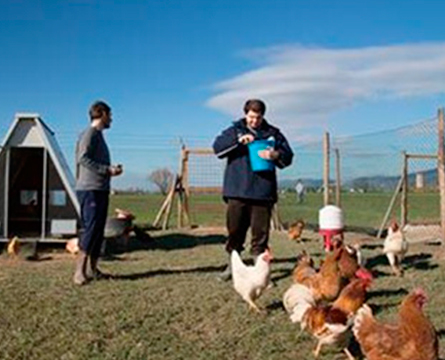
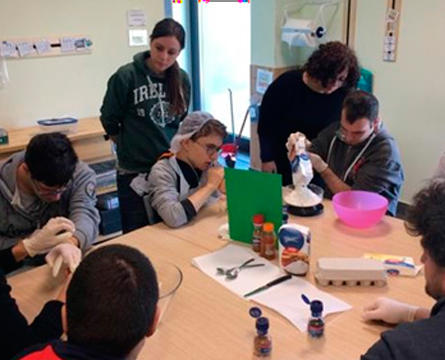
While social farms have been developed differently in the European countries, it can be seen as a way of addressing specific social needs and promoting innovative schemes of rural development that are rooted in rural resources and in multifunctional agriculture, defined as agriculture that can produce various non-commodity outputs in addition to fibres and food, available all over Europe.
Social agriculture, by combining the agricultural environment with rehabilitation, peripheral rural, social, educational and care services, benefits peoples’ quality of life and their social and work inclusion and represents an opportunity for farmers to broaden and diversify their businesses and incomes, to open up new markets and offer alternative services that go beyond fibre and food production.
The project aims at sharing and developing an innovative model based on good practices from previous experiences, mainly focused on the treatment of autistic persons (SWANS Project, 2011-2013), to widen the procedures and results to persons with different kinds of mental disabilities and social troubles and innovate the training materials for professionals concerned.
A focus of social agriculture and social farms is also based on the prevention of mental disorders and care of children and youngsters affected by stigma, targeted by bullying or hit by precocious depression and self-esteem collapse.
The triad constituted of Social Farm Tutor, Manager and Social/Health Educator is considered the essential team for implementing successful collaborations for social agriculture good practices.
The main target managing social users farms, are farmers and students interested to learn tutors for day-by-day social farm program, managers holding and or managing a social farm, and social/health educators introducing the disadvantaged trainees to the farm spaces, works and tutor for their follow-up.
Trainers from advisory services, policy makers and persons in charge of social/health services and rural development measures are also concerned as secondary target groups.
The modular course is oriented to soft and hard skills enabling the target users to manage on farm training, accommodation and services for persons with special needs, with a blended use of training methodologies based on learning-by-doing on the spot and internet technologies for e-learning.
2. VALUES OF SOCIAL FARMS FOR TRAINEES
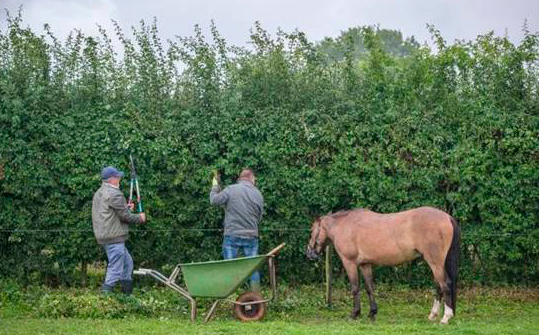 The power of social farming is about: Togetherness – Outside – Simply personal.
The power of social farming is about: Togetherness – Outside – Simply personal.
These three together are the strength of social farming.
The participants of social farms name as valuable:
- I am seen, and heard / I feel I belong somewhere
- It’s on the farm just like in normal life
- I get the chance to learn
- I do useful work
- I exercise a lot on the farm
- There is space, and I can be outside a lot
- The rhythm on the farm gives me something to hold on
- We eat healthy together
Research shows that the relatives of participants, the social farmers and other involved also see these core values as what should be central on a care farm.
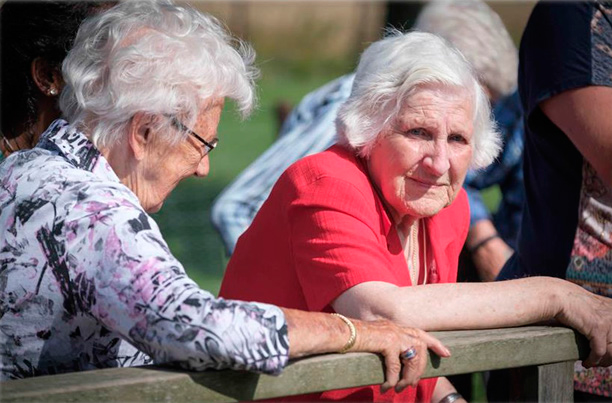 Social farms combine the agricultural environment with rehabilitation, care, social, educational services and work inclusion, benefits peoples’ quality of life and their social inclusion.
Social farms combine the agricultural environment with rehabilitation, care, social, educational services and work inclusion, benefits peoples’ quality of life and their social inclusion.
Social farms offer daytime activities and (supervised) work and sometimes also housing facilities for participants with all kinds of disabilities and social disadvantages.
Some social farms provide care to a mix of the various target groups.
Others choose for a specific target group.
Social farms offer guidance to different groups of participants, for example:
- People with psychiatric problems
- Mentally retarded people
- People recovering from addiction
- People with learning difficulties
- Elderly
- Children with or without learning and developmental difficulties
- Young people with behavioral problems
- Long-term unemployed
- Immigrants/ refugees
A lot of research has already been done into what participants experience as special qualities on a social farm. On the next sheets we describe as an example what three target groups experience.
People with a psychiatric background mentions as qualities of the social farm: Appreciate being treated as a normal person, with respect, without prejudice and not a a patient. Receiving positive feedback and taking responsibility gives confidence. Able to work at your own pace. The farm provides structure, peace and space, less stimuli, mor freedom and an informal atmosphere. The opportunity to withdraw for a while. The opportunity to make new contacts and the diversity of the group of participants.
Elderly mention the involvement and personal relationship with the farmer. Being able to do meaningful work and be part of society. The farm offers a wider range of activities than traditional day centers and this has an activating effect. The beautiful open view. The authentic farm environment activates the memory. The friendliness of the group. Feeling appreciated.
The Youngsters:
Research shows many positive effects in the youngsters with multiple problems who live and work (experiential learning) on the social farm.
Farm context:
Away from your own context (friends, youth care), role model and involvement of farmer and family, being thrown back on yourself, structured environment with a low stimulus. Physical and challenging work, gain experience. There is less aggression on the farm than at school or in residential youth care. Feeling at home on the farm, more freedom and an informal atmosphere.
Process of the Youngster:
Integrating positive experiences in a new (home) situation, having a role as an employee and not as a participant, reflection on the past, increased selfesteem and self- confidence, increased locus of control.
Become more independent, learn to communicate better, learn to persevere, take responsibility, build a new network.
Effects:
Decrease in behavioral problems, less recidivism, less substance use, less appeal to youth care. Back to school or work, recovery/improved contact with parents, recovery of daily routine, improvement of choice friendships.
Social farms fit in well with the philosophy of community care, education and rehabilitation, empowerment and recovery of participants. The care provided on the farm is based on equality, involvement, options, compassion and professionalism.
Each working area on a farm has specific activities and qualities. For a social farm it is important to develop sufficient variation in activities and make the best possible use of the differences between these working areas. The qualities only come into their own if the facilitator himself is enthusiastic and can convey this enthusiasm to the participants.
On a social farm you can create places where work is central: where you can get rid of your energy, where you exert yourself. But there are also places where it is about the experience of the green space, where you can enjoy the silence, smells, colors and (natural) sounds. Both places can be entrances for experiencing safety, challenge and involvement. Even though each work area can be varied in the emphasis placed on ‘work pressure or attitude’ and on ‘experience’, one work area has more work pressure and lends itself more to learning a work attitude while another work area offers more opportunities for experience. In addition to the aspects of perception and work pressure, work areas also differ in other aspects, such as possibilities for contact, size of the workspace and predictability of the work, as indicated above. Being aware of these qualities and the characteristic differences between work areas offers counselors the opportunity to use work areas more specifically for different participants.

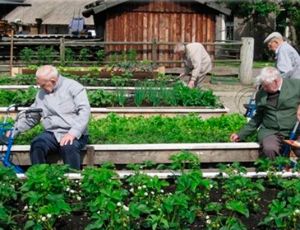
| WORK AREA | ACTIVITIES | CHARACTERISTICS | POSSIBLE GOALS AND TARGET GROUPS FOR WHICH WORK AREA IS ESPECIALLY SUITABLE |
|---|---|---|---|
| Working with horses | taking care of horses, mucking out horse riding, vaulting, therapy | Animal you can develop a strong bond with | young people; working on a relation; social interaction; develop confidence and firmness, ‘learn to direct your life’ |
| Bakery | Making dough Baking bread, cookies and cakes | Creative process Attention and Accuracy | Developing work rhythm, attention, accuracy |
| Gardening | Sowing, planting, spading, transplanting, hoeing, weeding, harvesting | Seasonal rhythm. Various environments: greenhouse, herbs, flowers, open field horticulture | Insight into own processes. See movements in seasons and life |
| Household, agritourism activity |
Making coffee, tea. Preparing lunch. Cleaning. Washing | Caring. Many Contacts. Collaborate in a small space. Repeating tasks | Suitable for vulnerable people Learn to take care of yourself |
| Livestock farming | Bringing livestock to pasture, mucking out, feeding, milking | Incalculability of animals. Direct appeal from animals. Bond with animals | Restore trust in hurt people. Come in motion. Learning limits. Developing ‘firmness’ |
| Food serving industry, catering |
Taking and delivering orders. Handling cash register. Making sandwiches, salads | Contacts with customers Representative. Unexpected situations | Contact with customers. Dealing with compliments and complaints |
| Ornamental garden |
Setting up and maintaining grounds. Take care of the garden. Taking care of trees | Little work pressure. Room for creativity. caring. Visible. Close to home | Suitable for vulnerable people. Learn to make your own choices |
| Landscape management | Prune, knot. Maintain paths Split woods | Little work pressure. physical work Effects visible over a longer period | “Ground” Physically gain strength |
| Dairy processing | Making cheese, yogurt, cottage cheese To clean. Filling and labeling bottles Brushing and turning cheeses | Clean, precise work. Enclosed, isolated space. Few impressions from outside. Fixed work | Developing structure. Develop accuracy and alertness.Learning boundaries in perfectionism |
| Shop | Sell vegetables, dairy. Taking care of retail space. Restock. Contact with customers. Handling cash register | Contacts with customers. Store representative. Unexpected situations | Contact with customers. Dealing with compliments and complaints |
| Technic | Tinkering, assembling technical matters | Non-green activity. Technical Insight required | Young people; especially boys |
3. THE SOCIAL FARM TUTOR
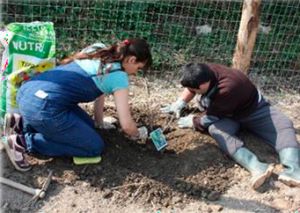 The Social Farm Activities will be planned and tailored to the trainee based on a preliminary psycho-attitudinal evaluation made by the social/health services and a related program listed by the Social Farm Manager depending on the offer available in the social farm, such as in example:
The Social Farm Activities will be planned and tailored to the trainee based on a preliminary psycho-attitudinal evaluation made by the social/health services and a related program listed by the Social Farm Manager depending on the offer available in the social farm, such as in example:
- gardening and horticulture,
- bread and pastry making,
- animal care,
- clay, paper and wood works, etc.
Before giving detailed examples of field activities and indoor laboratories it is important to explain roles, tasks, and soft skills needed by the Social Farm Tutor.
The Social Farm Tutor is a person responsible for the field organization of the planned rehabilitation/work individual program agreed between the social/health services and the social farm manager.
At the beginning, an educator sent by the social/health services will help the trainee become familiar with the farm environment, confident in the tutor and willing to be involved in the field activities.
This collaboration is fundamental to start good collaborative relationships between the tutor and the trainee and facilitate the trainee’s inclusion.
The faster the inclusion, the more the presence of the social/health educator will be progressively reduced.
The Social Farm Tutor should have specific and transferable skills necessary to perform a job (hard skills) and soft skills (such as the ability to communicate well, the ability to be a reliable point of reference for the person who participates in social agriculture.
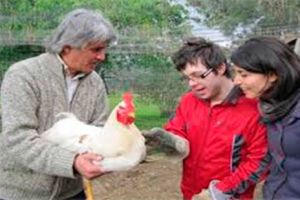 Communication competences
Communication competences- Acceptation of professional remarks
- Ability to cooperate/to work in a team
- Participation skills
- Empathy
- Diversity skills
- Self reflection
- Organizational competence
- Learning competences
- Competence to act
- Responsibility
Communication competences: being able to express oneself in a comprehensible and recipient-oriented way and refers to one’s own willingness to exchange ideas with others, to clarify things verbally and to pass on knowledge through communication.
The learning outcomes are that the Social Farm Tutor is able to:
- speak a simple and also with a complex language
- understand simple and complex language
- use a polite language
- give understandable and appreciative feedback (motivation)
- use a calm language in conflict situations.
Acceptation of professional remarks: this is understood on the one hand as the ability to give people positively and negatively remarks and advices in the sense of the person and the matter, and on the other hand as the ability to accept remarks and advices in the sense of the person and the matter itself and to process it productively.
Learning outcomes for the Social Farm Tutor:
- accepts and uses remarks to improve his/her job
- compares her/his behaviour after receiving remarks
- is able to listen to professional remarks
- is able to give professional remarks
- values her/his work correctly.
Ability to cooperate/to work in a team: having the ability to cooperate means having a strong interest in a common result or success. In doing so, everyone contributes according to their abilities and knowledge. The focus is on cooperation, on learning together. It is also important to be open to others and to have the ability to take a step back.
Learning outcomes for the Social Farmer Tutor:
- is able to work with different people together
- knows that different people have different interests
- can accept this
- knows that there may be conflicts when working together
- can accept this.
Participation skills: the noun participation means “involvement” or “participation”. In the sense of participation, as many as possible are involved in a decisionmaking process.
In this sense Participation competence means also the willingness of being part of the progress and the willingness to participate actively.
Learning outcomes for the Social Farm Tutor:
- is interested in her/his environment
- is interested in contributing oneself and one´s opinion.
Empathy: refers to the ability and willingness to recognize, understand and empathize with the sensations, emotions, thoughts, motives and personality traits of another person. A general language term corresponding to this is compassion.
Learning outcomes for the Social Farm Tutor:
- listens and is open to ideas and perspectives of others
- knows what is empathy/compassion (distinguishing compassion from pity)
- balances empathy with boundaries (professional/work and personal/private).
Diversity competences: means to consciously perceive the differences between people and to value them in their diversity – regardless of gender, sexual orientation, age, origin and nationality, religion and ideology or disability.
Learning outcomes for the Social Farm Tutor:
- recognises the difference of people in their religion, speech, sex, age, meaning.
- knows that difference is part of life
- knows that difference brings new perspectives and enrich one`s life.
Self-Reflection: means something scrutinising and comparing thinking about oneself or one’s own behaviour, pondering (when it is related to a mental activity).
The corresponding verb is to reflect and stands for to ponder, think through or ponder.
Learning outcomes for the Social Farm Tutor:
• a. knows how to think and questions thinking, acting and feeling with the aim of finding out more about her/himself not only as an individual also as part of a system e.g. a team.
Organizational competence: refers to the talent of being able to plan and order schedules and work processes for the optimal use of labour. Organizational talents set priorities, which means that important tasks are done first, and unimportant tasks follow.
Learning outcomes for the Social Farm Tutor:
- is able to plan and organise work
- can give support in planning
- can give support in organising the working surrounding.
Learning Competence is an active, self-directed, constructive, situational and social process:
- Learning needs active participation of the learner
- Learning always requires participation of the self
- Knowledge is always constructed. New knowledge can only be acquired and used if it is built into existing knowledge structures and interpreted on the basis of individual experience.
- The construction of knowledge takes place in contexts and is connected to them; learning is therefore situational.
- Learning also takes place against the background of socio-cultural conditions and often within a social framework.
Learning outcomes for the Social Farm Tutor :
- is open to new learning experiences and further training (according to “you never stop learning”, lifelong learning)
- understands changes as a part of life
- remains curious
- knows that mistakes are a learning potential.
Competence to Act: Action competence is understood as the readiness and ability of the individual to behave in professional, social and private situations in an appropriately thought-out and individually and socially responsible manner.
Learning outcomes for the Social Farm Tutor:
- tries to solve problems
- takes care of ones health
- takes care of the health of others.
Responsibility competence: is primarily the ability to assess one’s own ability and the possible consequences of decisions and to act in such a way that the expected goals are achieved with the greatest probability.
Learning outcomes for the Social Farm Tutor:
- performs tasks reliably
- is able to ask for support when needed
- can act with foresight
- deals with challenging situations in a prudent manner.
* See workbook for more explanation about observing & reporting
The social farm tutor is a person not only trained leading work based on hard skills (farming skills and abilities) but the social farm tutor also has to improve the social skills from the participants (collaboration and interpersonal relationships).
In this respect the collaboration within the triad social farm tutor/farm manager/professional, each one of them with their own competences, is a notable part of the inclusion capacity at work of a person with mental or social disorders.
Sharing and collaboration are the key words for those in the social farm triad.
4. WORKING METHODICALLY
Focused observation is:
Systematic observation means observing long enough and observe at different times.
Goal-oriented: Your observations should be directed toward a predetermined goal. That way you can focus on what you need to observe.
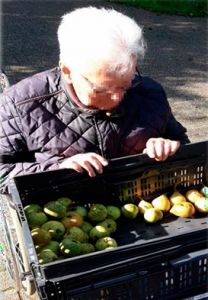 Accurate: the observation must describe the behaviour; the reader must be able to read what happened. That is why we must present the situation as accurately and completely.
Accurate: the observation must describe the behaviour; the reader must be able to read what happened. That is why we must present the situation as accurately and completely.
Objective: An observation should represent reality as faithfully as possible. That means you must represent what your senses perceive as factually as possible. So, what you see, hear, maybe feel and smell is important and not what you think and feel. The latter matters are presented in an interpretation.
As an observer there are different ways to participate in the situation to be observed, this can be:
- Actively participating
- Passive Participating
- Non-participating
Register: After observing you must record what you have observed. This can be done by means of a descriptive observation, with observation schemes, assessment schemes or a combination of these methods.
Reports: Reporting is often done daily with the so-called daily report. In addition, care or guidance plans are written. Based on objectives in care plans, you observe in a targeted manner, and you also report in your daily report aimed at the formulated goals.
Content: When communicating, you should always take the target group into account. Colleagues may use different words than when talking to a family member. The report must be as objective as possible. That is why you first report the facts, then you give your own interpretation. Everyone should know the difference between main and side issues. Then you give your interpretation & conclusion.
Language: You create structure by means of sentences, paragraphs, chapters, headings and signal words.
For good care and/or support, working according to a plan is important, mostly this is referred to as working methodically.
The basics of working methodically are:
- Collect the necessary information – observations and daily reports are your main sources of information, But also use the participant, family, other professionals
- Identifies wishes, needs and problems – what does the participant need, what wants the participant
- Sets goals – together with participant, short and long term goals
- Plan the activities – make the activities concrete and make a planning
- Monitor progress – look at the reactions of the participant, but also look at yourself critically
- Evaluate and adjust care and support if necessary.
Working methodically is a cyclic process:
This means that adjustments are made on the basis of the evaluation of the care/support Then the cycle starts again by gathering information, setting goals, and so on.
Advantages of working according to plan (methodically):
- Less chance of errors because there is more control over what happens and people can/must see further ahead
- Clear expectations: you but also others know what to expect
- Evaluation and improvement: One’s own actions can be better evaluated in order to improve actions if necessary
- Accountability & Collaboration
Goal of an activity is to maintain, improve, broaden and deepening or stabilizing skills of the participant. Always keep in mind that activities are the tutor’s tools. Activities are never the goal in themselves.
The Activity Plan is always part of a planned working process (methodically working) i.e. you work:
Methodical: think about the activities, methods, means and goals you (in relation to the participant) want to reach
Systematic: consistent in actions, work with a timeline (when, with whom and for how long a certain action)
Process: take into account the developments over time (e.g., are we going too slow or too fast, is it possible for the participant to keep up with me)
When drawing up a activity plan always consider:
- Structure: the logical sequence of all the sub-activities, in order to complete the activity
- Timing of the activity: how long, when, how does it fit in other activities
- Supplies needed: material like wood, straw, paper and what tools are needed for the activity
- Participant requirements: each activity has its own difficulty level and skills that are needed.
- Space: What kind of work space is needed for the activity, are adjustments needed
- Safety technical i.e. regulations, materials that are used, but also attitude of the social farm tutor
- Personal safety of the participant i.e. comfort zone, abilities of the participant
- Personality of the participant determine also which activities you do and how you do them
- Guidance attitude: for each participant it is clear how to deal with his/her reactions i.e.. complaining, tiredness.
STEPS TO TAKE AND QUESTIONS TO ANSWER WHEN DRAWING UP A PLAN |
||
|---|---|---|
| Starting situation | Who is the participant, what are the possibilities and obstacles What are the needs/wishes, what does the activity mean for the participant What are your observations during activities with the participant |
|
| Formulate the goals | Which educational goal(s) do you want to achieve with the participant | |
| Organisation | Practical: How can the goal(s) be achieved, practical what to think of (see sheet number ….) Educational: How will the guidance be for the participant |
|
| The implementation | Was the implementation of the activity according to the prepared plan | |
| The Evaluation | What has been the value of the activity Has the goal(s) been reached What should be different next time (process evaluation) |
|
* See the workbook for extensive supporting questions and examples of activity plans
5. SUPPORT & GUIDANCE MODELS
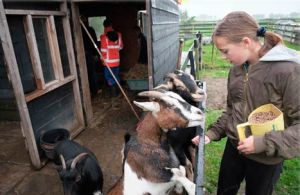 Motivational interviewing: is a methodology that increases participants’ motivation to change behaviour by exploring and reducing conflicting feelings, or ambivalence, about change, thereby increasing the commitment to change.
Motivational interviewing: is a methodology that increases participants’ motivation to change behaviour by exploring and reducing conflicting feelings, or ambivalence, about change, thereby increasing the commitment to change.
Solution Focused Communication: as the name suggests the communication is future-focused, goal- directed, and focuses on solutions, rather than on the problems. It helps participants change by constructing solutions rather than focusing on problems.
Autism Communication: is communication that is tailored to the specific way in which people with Autism Spectrum Disorder (ASD) process and communicate information. The communication creates understanding and respect and therefore positive contact, resulting in development. This way of communication is useful and applicable for every age and intelligence, for anyone with autism and for anyone who needs clarity.
Social Competence Model: Working on the basis of the competence model means that the social farm tutor focuses on increasing competence, i.e., connecting with and strengthening (potential) strengths in the participant and/or the immediate environment. The emphasis is on a positive approach: it concerns learning new behaviour, with the ultimate goal that an individual can acquire a useful and meaningful place in society.
Motivational Interviewing has four principles. The tutor works from these four principles. Not as a trick, but intrinsically convinced that these elements are essential in helping the other person.
1. Partnership: participant and tutor work together based on true equality. Although their expertise differs, both are experts and need each other. The participant is an expert in himself and his daily life.
2. Acceptance: The tutor’s accepting attitude tries to allow the participant’s autonomy to function at full strength.
3. Compassion: the tutor does everything to serve the interests and wellbeing of the participant as optimally as possible.
4. Elicit: the tutor tries to purposefully investigate and understand the participant’s thoughts and feelings in order to discover and strengthen his intrinsic motivation (i.e., goals, wishes and expectations).
Five skills are described as being the basic skills in Motivational Interviewing.
These are:
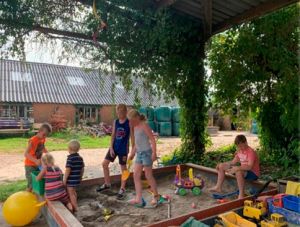 1. Asking Open question: invites the participant to tell his or her story. These start with question words: how, what, where, which.
1. Asking Open question: invites the participant to tell his or her story. These start with question words: how, what, where, which.
2. Reflective listening: The purpose of the reflection is to give back to the participant what he said or meant and shows that you have listened and that you are trying to understand the other person. What I hear you say is…
3. Confirm: Describing what is going well and what is successful plays an important role in the change process.
4. Summarize: you show that you have listened and is a way to structure conversation.
5. Give information and advice, with the participant’s permission: always ask for permission before you give information, see what the participant already knows. This technique helps to give information that the participant is open to, will listens to and is possibly useful.
Evoking self-motivational statements is a primary goal of Motivational Interviewing. The goal is to help the participant identify and resolve ambivalence so he or she can move forward.
Strategies for evoking change talk:
Ask evocative open questions: the answer to which is likely to be change talk.
In what ways does this problem concern you?
Ask for elaboration/examples: when a change talk theme emerges, ask for more details.
Give an example of what a good day looks like?
Explore decisional balance: What are the pros and cons of making changes?
Looking back questions: ask about a time before the problem emerged.
How were things better/different before ….?
Use change rulers: to explore readiness to change On a scale of 1 to 10, how important is it to you to change [the specific target behaviour], where 1 is not at all important and a 10 is extremely important?
Query extremes: What are the best (or worst) things that might happen if you do make this change?
* See workbook for more examples of the solution focused communication
The core of Solution Focused Communication is that the focus is on the desired situation, not on the problem; on successes, not on failures; resources and capabilities, not weaknesses and limitations. Small steps become clear, on the way to that desired future. it is practical, future-oriented and widely applicable.
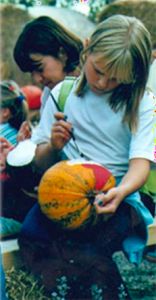 From problem to wish: you let go of the problem for a while and focus on the desired result. What do you want instead of the problem? (even though you may not know how yet), what will be different then?
From problem to wish: you let go of the problem for a while and focus on the desired result. What do you want instead of the problem? (even though you may not know how yet), what will be different then?
Acknowledge the other: For you as a professional, this means listen very carefully to the other person’s story and recognize that change is sometimes more difficult than it seems because someone has been through a lot or because there is a limitation. It also means that you always connect with the possibilities and impossibilities of the other. Then you can work from acceptance, and you can explore together where wishes and possibilities lie.
Mirror In your contacts you always hold up a mirror to the other. By mirroring you focus your attention on something and reinforce it. It is therefore important to ask yourself what you want to mirror. What do you want the other person to see in that mirror? By always focusing on what works, you stimulate the other person to do that more and you make him stronger to be able to deal with what is not (yet) going well. Instead of advising and solving, you always connect with what works for the other person. That way you help the other to help themselves.
Connecting: By connecting to the ideas and wishes of the other person, you don’t have to pull the cart, but you join the movement that is already there. The other leads and you help by zooming in on the right changes, recognizing and amplifying them. By paying extra attention to what is going well and by expanding this, where possible, we are working on a solid basis from which goals can be achieved.
There are lots of techniques used in SFC to shift the participant’s awareness onto focusing on the future and on a solution. These techniques include the miracle question, coping questions, exceptions to the problem, compliments, and using scales, which are explained in more detail below:
Miracle Question: is a technique that requires practice, but the format is: May I ask you a strange question? You will go home, have dinner, look television and then you go to sleep. While you are sleeping a miracle happens. You wake up in the morning . . . . . and how would you notice that the problems you were struggling with have disappeared?
This question can help identify and gain greater understanding of what the problem is, how it is affecting the person, and can provide motivation into wanting to move forward and overcome it, after imagining what it could be like to wake up without it (De Shazer et al., 1986).
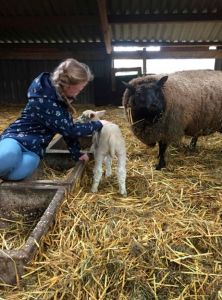 Coping Questions
Coping Questions
Coping questions are questions that the practitioner will use to gain understanding of how the person has managed to cope.
Examples of coping questions include: ‘After everything you have been through, I am wondering what has helped you to cope and keep you afloat during all this?’; ‘I feel to ask you, what it is exactly that has helped you through this so far?’. These questions cause the participant to identify the resources that they do have available to them, including noticing the internal strength that has helped them make it thus far, which they might not have been consciously aware of before (De Shazer et al., 1986).
Compliments
This involves the tutor actively listening to the participant to identify and acknowledge their strengths and what they have done well, then reflecting them back to the participant, whilst also acknowledging how difficult it has been for them. The tutor will use direct compliments (in reaction to what the participant has said), for example, ‘that’s amazing to hear!’, ‘wow, that’s great’.
Scales
The tutor will ask the participant to rate the severity of their problem or issue on a scale from 1-10. This helps both the practitioner and participant to visualize where abouts they are with the problem or issue.
‘On a scale of 1 to 10 where would you rate your current ability to achieve this goal?’; ‘From 1-10 how would you rate your progress towards finding a job?’; ‘Can you rate your current level of happiness from 1-10?’;
* See workbook for more examples of the autism communication
Understanding Autism: You want positive contact with the participant. Then it is important that you learn to understand the participant’s autism. The participant is unable to adapt to you. That is why you must adapt to him in the first place. By immersing yourself in his way of thinking, you learn what he wants to say and what he needs to be able to listen to you. This will create a safe base and the foundation for a positive contact is laid. As you may know, information processing in someone with autism is fragmented. Every person receives information in separate pieces, your brain puzzles those pieces back together into a logical whole. In someone with autism, disturbances hinder the processing of information. This means that not all information arrives at the same time in the brain of someone with autism and that the puzzle is often difficult to put together. If the puzzle remains incomplete, it is difficult to figure out exactly what to do. There is also a lack of cohesion.
There are 5 basic steps you should take when you communicate a task with someone with autism:
You tell very factually WHAT should be done, HOW the task should be done, WHERE it should be done, WHEN it should be done and (with) WHOM. This costs CASS less puzzle time and provides clarity. By naming it, you help to glue the right puzzle pieces in CASS’s head into one complete puzzle.
Use these questions if you want more clarity and predictability, or if you want to make an appointment. The formulation, of course, depends on the event, situation or subject. With these 5 questions you have a handy tool to gain more clarity and predictability in your participants life.
Some tips
- Be explicit, for example don’t say right away we go, but in 5 minutes we go
- Avoid using metaphors, People with autism often take words literally. ‘Having a knot in your stomach’ does not mean much to someone with autism. Say exactly what you mean.
- Make sure that your verbal and non-verbal messages do not contradict each other.
- Saying “yes” and shaking your head at the same time sends off a confusing signal.
- Keep enough physical distance. People with autism are often hypersensitive to sensory stimuli and can panic when touched.
By using the technique of autism communication, you bring coherence between the parts of a task.
Make a step – by – step plan for the person with autism, this will create clarity and peace. Visualization can be an important tool when creating a step-by-step plan.
You can also make the step-by-step plan as specific as necessary with the help of pictograms.
This way of communication also works very well when working with people with mental illness.
Techniques to teach the participant various skills:
A. Break down skills into steps
Describe the different steps that make up a skill in observable terms. Maximum 4/5 steps per skill, otherwise you must break it down again into more skills.
B. Giving feedback on adequate behaviour (you can never do that enough)
Make a positive or encouraging comment. Be specific about what the participant is doing well. Indicate why this is good (mention the positive consequences for the participant)
C. Giving a why
Make it short and concise.
It must relate to the appropriate conduct. (so don’t give a why for the unwanted behavior!) Connect to the participant’s experience.
D. Behavioural suggestion
1. Make contact; 2. say what the participant did well. 3. Be specific about what the participant did less well; 4. Give your suggestion (or ask alternative); 5. Give a why; 6. Check whether the participant can do something with it
E. Corrective Instruction
1. Connect; 2. Say what the participant does well; 3. Say what the participant does not do well. 4. Tell what the appropriate behavior is; 5. Give a why; 6. Close the conversation
F. Instruction with demonstration and practice
Collect information (about the situation in which the desired skill is needed) demonstrate (Tutor plays the participant’s role) practice (imitate, participant is himself/herself).
G. Feedback systems
E.g., points card is a feedback system in which the participant can earn points for adequate behavior using the card. Intended for residential facilities
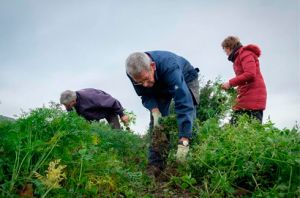 H. Structuring tasks
H. Structuring tasks
Is a task alleviating intervention. When skill deficits cannot be compensated. This makes tasks clearer and more manageable. You can do this by:
- Divide tasks into subtasks
- Offer a time perspective
- Ask the environment to help
- Do things together
* See workbook for more back-ground of the social competence model approach
Ambivalence the state of having mixed feelings or contradictory ideas about something or someone.
Autism is a congenital pervasive developmental disorder characterized by limitations in social interaction and (non-)verbal communication and by a limited, repetitive or stereotypical pattern of behavior.
Empathy is the ability to understand and share feelings of another.
Empowerment is viewed as a process: the mechanism by which people, organizations, and communities gain mastery over their lives.
Intrinsic motivation is the act of doing something without any obvious external rewards. You do it because it’s enjoyable and interesting, rather than because of an outside incentive or pressure to do it, such as a reward or deadline.
Experiential Learning is the process of learning by doing, through experience.
Pictograms is a symbol or image that takes the place of a text. Its use is therefore also called visual language.
Social agriculture, or social farming as it is also called, defines short or longterm activities that use agricultural resources such as animals and plants to promote and generate social services in rural areas.
Social farm manager can be defined as a person responsible for planning and managing a program of social agriculture.
Social farm tutor can be defined as a person who is trained to work with people with a range of needs and abilities in a social farming environment.
Social health professional can be defined as a person an employee of the social health cooperatives skilled in assistance to persons with special needs.
Target group this is a specific group of people that an organization or institution wants to reach with a specific offer or program.
Triad a group or set of three related people or things.
Vulnerable persons people with weak points or disadvantages.
Youngster a young person of either sex, not an adult yet.
Bekar, Ö. (2021): Kooperationsfähigkeit: Testen und Fördern, kooperationsfaehigkeit (07.04.2021)
https://www.einstellungstest.de/sozial-kommunikative-kompetenz
Bekar, Ö. (2021): Organisationsfähigkeit und Planung: Testen Sie effektiv, (07.04.2021)
https://www.einstellungstest.de/aktivitaets-und-umsetzungsorientiertekompetenz-
organisationsfaehigkeit-und-planung
Berger, R. and McLeod, J. (2006) ‘Incorporating nature in therapy: a framework for practice’. Journal of Systemic Therapies
Berget B. (2008) Animal assisted therapy: effects on persons with psychiatric disorders working with farm animals. Ass: University of Life Sciences of Ass, Noorwegen.
De Bil, P; Observeren, registreren, rapporteren en interpreteren ; Boom/Nelissen · 9789024403332
De Shazer, S., Berg, I. K., Lipchik, E., Nunnally, E., Molnar, A., Gingerich, W., & WeinerDavis, M. (1986). Brief therapy: Focused solution development. Family Process, 25(2), 207– 222.
De Vries, S., R.A. Verheij, P.P. Groenewegen & P. Spreeuwenberg (2003) Natural environments, healthy environments? An exploratory analysis of the relationship between green space and health. Environment and Planning.
Dell’Olio M., Hassink J. , Vaandrager L. The development of social farming in Italy: A qualitative inquiry across four regions (2017) Journal of Rural Studies
Di Iacovo, F. and D. O’Connor (2009). Supporting Policies for Social Farming in Europe. Progressing Multifunctionality in Responsive Rural Areas. ARSIA, Firenze
European Commission Results of four pilot projects on employment of persons with autism (2014) ISBN 978-92-79-36224-2 Federatie Landbouw & Zorg, Kernwaarden van Zorglandbouw – concept – FLZ -Voorthuizen Nederland, 2021
Goijarts, F., Van der Veen, M. (2012 of later) Motiverende gespreksvoering voor sociaal agogisch werk; coachen bij gedragsverandering. Houten: Bohn Stafleu van Loghum.
Han Spanjaard en Marijke van Vugt Handleiding voor kortdurende ambulante jeugdzorg gericht op competentievergroting ISBN: 9789085600206
Hassink J. et al. (2016) Entrepreneurship in agriculture and healthcare: different entry strategies of care farmers, Journal of rural studies, Elsevier
Hassink J. et al. (2016) Entrepreneurship in agriculture and healthcare: different entry strategies of care farmers, Journal of rural studies, Elsevier
Hassink J., Hulsink W., Grin J. Entrepreneurship in agriculture and healthcare: Different entry strategies of care farmers (2015) Journal of Rural Studies
Hassink. J (2009), Kwaliteiten werkgebieden op zorgboerderijen, Plant Research International B.V., Wageningen
Hassink. J (2011) Effectiviteit van ervarend leren op de boerderij, Orthopedagogiek: Onderzoek en Praktijk, 50 (2011)
Hassink. J (2011) Waarden van Landbouw en Zorg, Stichting Dienst Landbouwkundig Onderzoek (DLO)
Hassink. J (2017) Exploring the role of farm animals in providing care at care farms http://www.mdpi.com/journal/animals Hulpverlening voor kinderen en jongeren in tehuizen ISBN: 9789055746392
Insoo Kim Berg and Solution-Focused Therapy John D. West, Donald L. Bubenzer, Jeffrey M. Smith et. All. October, 1997 Research Article https://doi.org/10.1177/1066480797054014
Lamb (2009) Creating change: using the arts to help stop the stigma of mental illness and foster social integration, Journal of Holistic Nursing, (ver. 18.01.2019) https://journals.sagepub.com/doi/10.1177/0898010108323011
Lamb J. (2009) Creating change: using the arts to help stop the stigma of mental illness and foster social integration, Journal of Holistic Nursing, (ver. 18.01.2019) https://journals.sagepub.com/doi/10.1177/0898010108323011
Mandl, H. & Krause, U.-M. (2001). Lernkompetenz für die Wissensgesellschaft (Forschungsbericht Nr. 145). München: Ludwig-Maximilians-Universität, Lehrstuhl für Empirische Pädagogik und Pädagogische Psychologie.
Neueswort.de: Partizipation: Bedeutung, Definition, Beispiele & Herkunft, (12.03.2021) https://neueswort.de/partizipieren
Rocktäschel, Lucia Clara (2019): 5 Voraussetzungen für Diversity-Kompetenz in deinem Unternehmen, (12.03.2021) https://www.lucia-clara-rocktaeschel. de/diversity-kompetenz
Slot & Spanjaard, Competentievergroting in de residentiële jeugdzorg
SWANS Sustainable Work for Autism Networking Support (2013). Inclusion is possible : results of the SWANS project . Canalicchio M. et Al. ISBN 978-88-908958-0-7.
The Essential 5 https://www.geefmede5.nl/webshop/boeken
Torquati B., Vizioli V., Tittarelli A., Paffarini C. L’agricoltura si eleva al quadrato. Ali&no, Perugia
WHO (2011), World report on disability, (ver. 18.01.2019) https://www.who.int/disabilities/world_report/2011/accessible_en.pdf
Wikipedia: Empathie, (31.05.2021) https://de.wikipedia.org/wiki/Empathie
Wikipedia: Handlungskompetenz, (12.04.2021) https://de.wikipedia.org/wiki/Handlungskompetenz
Wikipedia: Kommunikative Kompetenz, (17.03.2021) https://de.wikipedia.org/wiki/Kommunikative_Kompetenz
Wikipedia: Kritikkompetenz, https://de.wikipedia.org/wiki/Kritikkompetenz
(17.03.2021)
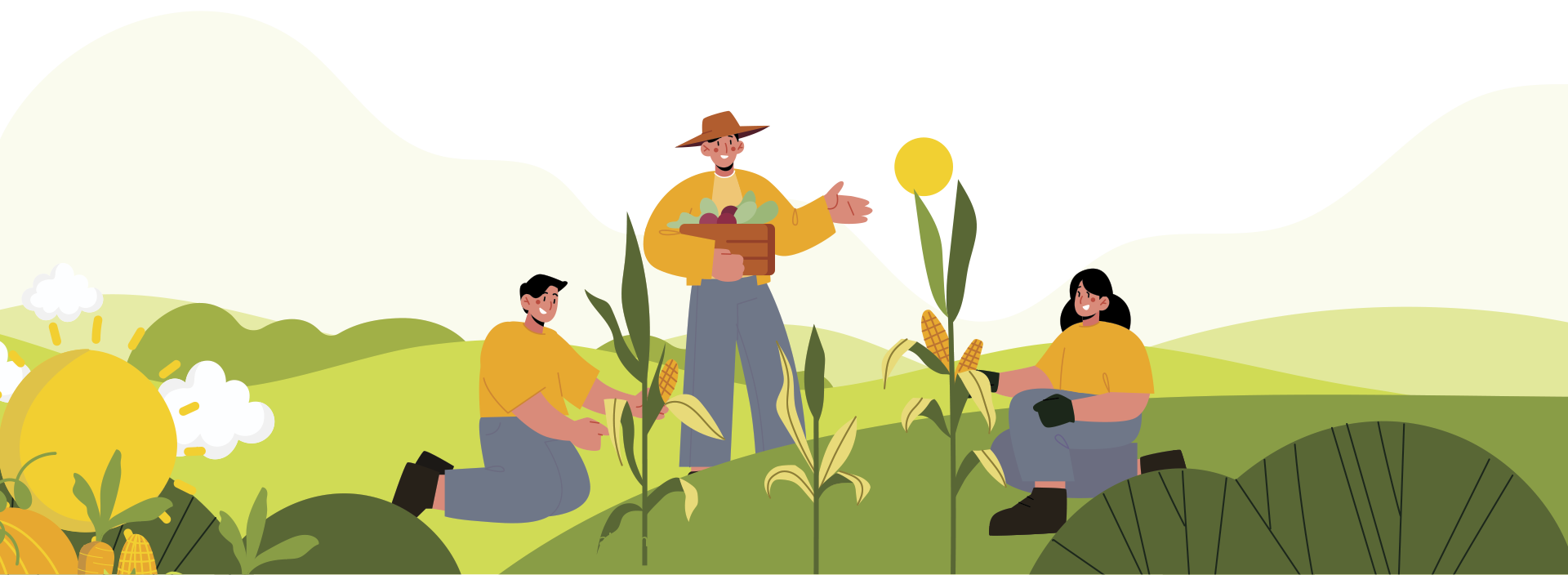
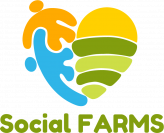
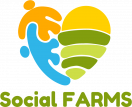
 BACK TO MODULES
BACK TO MODULES